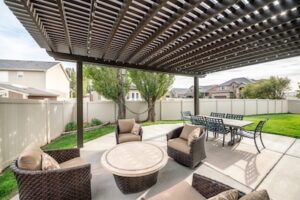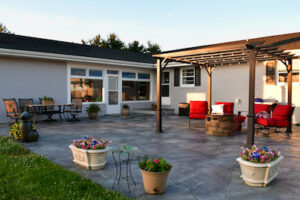How to Build a DIY Pergola: A Home Improvement Project for Summer Comprehensive Guide
If you’re looking to spruce up your backyard this summer, building a pergola might just be the project for you! Pergolas not only add style and elegance to your outdoor space, but they also provide shade and protection from the sun. In this comprehensive guide, we’ll take you through the step-by-step process of how to build a DIY pergola on your own! From materials to tools and everything in between, we’ve got you covered!
Materials Needed for How to Build a DIY Pergola: A Home Improvement Project for Summer Comprehensive Guide
Before we get started, let’s take a look at the materials you’ll need for this project:
- 6×6 treated lumber posts
- 2×10 treated lumber for beams
- 2×8 treated lumber for rafters
- 2×2 treated lumber for purlins
- 6×6 post anchors
- Concrete mix
- Lag bolts
- Carriage bolts
- Galvanized screws
- Joist hangers
- Post caps
- Wood sealer
- Decorative hardware (optional)
Tools Needed
You’ll also need a few tools to complete this project:
- Circular saw
- Power drill
- Hammer
- Post hole digger
- Level
- Measuring tape
- Chalk line
- Safety glasses
- Gloves
How to Build a DIY Pergola: A Home Improvement Project for Summer Comprehensive Guide
Now that you have all your materials and tools, it’s time to get started on building your pergola. Follow these steps to create your own outdoor oasis:
1. Determine the Location and Size of Your Pergola
The first step in building a pergola is determining where you want it to go and how big you want it to be. Consider the size of your backyard and the amount of shade you want your pergola to provide. Once you have a location in mind, use stakes and string to mark the corners of your pergola.
2. Dig the Post Holes
Using a post hole digger, dig holes at each corner of your pergola. The holes should be approximately 3 feet deep and 12 inches in diameter.
3. Set the Posts
Place a post anchor in each hole and fill the hole with concrete mix. Set the post in the anchor and use a level to make sure it’s straight. Repeat this process for all four posts.
4. Install the Beams
Cut your 2×10 beams to the desired length and place them on top of the posts. Secure them in place with carriage bolts.
5. Install the Rafters
Cut your 2×8 rafters to the desired length and attach them to the beams using joist hangers. Space them evenly apart.
6. Install the Purlins
Cut your 2×2 purlins to the desired length and attach them to the rafters using galvanized screws. Space them evenly apart.
7. Seal the Wood
To protect your pergola from the elements, apply a wood sealer to all the exposed wood.
8. Add Decorative Hardware (Optional)
If you want to add a decorative touch to your pergola, consider adding decorative hardware to the corners of your beams and rafters.

What to Consider When Building a Pergola for Your Home
Building a pergola is an excellent way to enhance the aesthetics and functionality of your outdoor space. Here are some important factors to consider when building a pergola for your home:
1. Location and Size
Before building a pergola, it’s essential to determine its location and size. Consider the amount of space you have available, the intended use of the pergola, and its proximity to your home and other structures. You’ll also want to ensure that the location receives adequate sunlight and shade, depending on your needs.
2. Materials
Pergolas can be made from a variety of materials, including wood, vinyl, aluminum, and steel. Each material has its pros and cons, so it’s essential to choose the right one based on your budget, style preference, and maintenance requirements.
3. Design and Style
Pergolas come in various designs and styles, including traditional, modern, and rustic. Consider the style of your home and outdoor space when choosing a design for your pergola. You may also want to consider incorporating additional features, such as lights, fans, or a retractable canopy.
4. Building Codes and Permits
Before building a pergola, you’ll need to check your local building codes and obtain any necessary permits. This will ensure that your pergola is structurally sound and meets all safety requirements.
5. Budget
Building a pergola can be a significant investment, so it’s essential to establish a budget before beginning the project. Consider the cost of materials, labor, and any additional features you want to include.
6. Maintenance
Regular maintenance is necessary to keep your pergola in good condition. Consider the amount of maintenance required for each material and choose one that fits your budget and lifestyle.
Overall, building a pergola requires careful consideration of several factors, including location, size, materials, design, building codes, budget, and maintenance requirements. By taking the time to plan and consider these factors, you can create a beautiful and functional outdoor space that you and your family can enjoy for many years to come.
The Benefits of a Pergola for Your Home
A pergola is a beautiful and functional addition to any outdoor space. Here are some of the benefits of adding a pergola to your home:
1. Provides Shade and Protection
A pergola provides shade and protection from the sun’s harmful UV rays, making it an ideal spot for outdoor activities during the hot summer months. It can also protect outdoor furniture from weather damage, ensuring that your investment lasts longer.
2. Increases Home Value
Adding a pergola to your home can increase its value, making it a worthwhile investment. It enhances the aesthetics of your home and creates a beautiful outdoor living space that can be enjoyed by your family and friends.
3. Versatile and Customizable
Pergolas come in a variety of sizes, shapes, and styles, making them a versatile and customizable addition to any outdoor space. You can choose a design that complements the style of your home and fits your specific needs and preferences.
4. Creates a Focal Point
A pergola creates a focal point in your backyard, making it an inviting and comfortable space for relaxation and entertainment. You can decorate your pergola with lights, plants, and other accessories to enhance its beauty and functionality.
5. Provides Privacy
If you have a large backyard or live in a busy neighborhood, a pergola can provide privacy and seclusion. It’s an excellent way to create an intimate outdoor space where you can unwind and escape the hustle and bustle of everyday life.
6. Low Maintenance
Pergolas are relatively low maintenance compared to other outdoor structures such as gazebos and covered patios. With the right materials and regular upkeep, your pergola can last for many years without requiring significant repairs or maintenance.
Overall, adding a pergola to your home is a great way to enhance its aesthetics and functionality while increasing its value. With the right design and materials, a pergola can provide shade, privacy, and protection from the elements much like a quality roof. Thus creating a beautiful and comfortable outdoor living space for you and your family to enjoy.

FAQs About How to Build a DIY Pergola: A Home Improvement Project for Summer Comprehensive Guide
1. How much does it cost to build a pergola?
The cost of building a pergola can vary depending on the size and materials used. On average, you can expect to spend anywhere from $500 to $5,000.
2. How long does it take to build a pergola?
The time it takes to build a pergola can vary depending on the size and complexity of the project. On average, it can take anywhere from a few days to a few weeks to complete.
3. Do I need a permit to build a pergola?
The need for a permit can vary depending on where you live and the size of your pergola. It’s always a good idea to check with your local building department before starting any home improvement project.
4. Can I build a pergola myself?
Yes, with the right materials and tools, building a pergola can be a DIY project. Just be sure to follow all safety precautions and instructions carefully.
5. What kind of wood should I use for my pergola?
Treated lumber is a good choice for pergolas as it is resistant to rot and decay. Cedar and redwood are also popular choices for their natural beauty and durability.
6. Can I attach a pergola to my house?
Attaching a pergola to your house is possible, but it’s important to do so correctly to ensure safety and stability. It’s recommended to consult with a professional if you’re unsure.
Conclusion
Building a DIY pergola can be a fun and rewarding project that adds beauty and functionality to your outdoor space. With the right materials, tools, and instructions, anyone can build a pergola. Just be sure to follow all safety precautions and local building codes. We hope this comprehensive guide has helped you get started on your pergola-building journey!
How to Build a DIY Pergola: A Home Improvement Project for Summer Comprehensive Guide
To summarize the steps involved in building a DIY pergola, here’s a quick overview:
- Determine the location and size of your pergola.
- Dig the post holes.
- Set the posts.
- Install the beams.
- Install the rafters.
- Install the purlins.
- Seal the wood.
- Add decorative hardware (optional).
Remember, building a pergola takes time and effort, but the end result is worth it!
